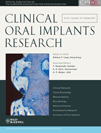Alveolar ridge dimensions in maxillary posterior sextants: a retrospective comparative study of dentate and edentulous sites using computerized tomography data
Abstract
Aim: To compare the alveolar ridge dimensions between edentulous sites and contralateral dentate sites of maxillary posterior sextants in the same individuals.
Materials and methods: Computerized tomography scans of 32 patients with one fully edentulous and one fully dentate maxillary posterior sextants were analyzed.
Results: When compared with dentate sextants, edentulous sextants showed (i) a lower bone height (BH) at second premolar, first molar and second molar sites, which was associated with a more coronal position of the maxillary sinus floor at second premolar site; (ii) a more apical position of the ridge at second premolar and second molar sites; (iii) a lower bone width (BW)1 mm at first and second premolar sites, and a lower BW3 mm at all sites, (iv) a lower, although not significant, prevalence of premolar and molar sites with BH≥8 mm and BW1 mm≥6 mm.
Conclusions: The edentulous sextants in the posterior maxilla showed a reduced height and width of the ridge when compared with contralateral dentate sextants. The reduced vertical dimensions observed in edentulous sextants were variably associated with ridge resorption as well as sinus pneumatization.
To cite this article: Farina R, Pramstraller M, Franceschetti G, Pramstraller C, Trombelli L. Alveolar ridge dimensions in maxillary posterior sextants: a retrospective comparative study of dentate and edentulous sites using computerized tomography data.Clin. Oral Impl. Res. 22, 2011; 1138–1144.doi: 10.1111/j.1600-0501.2010.02087.x




